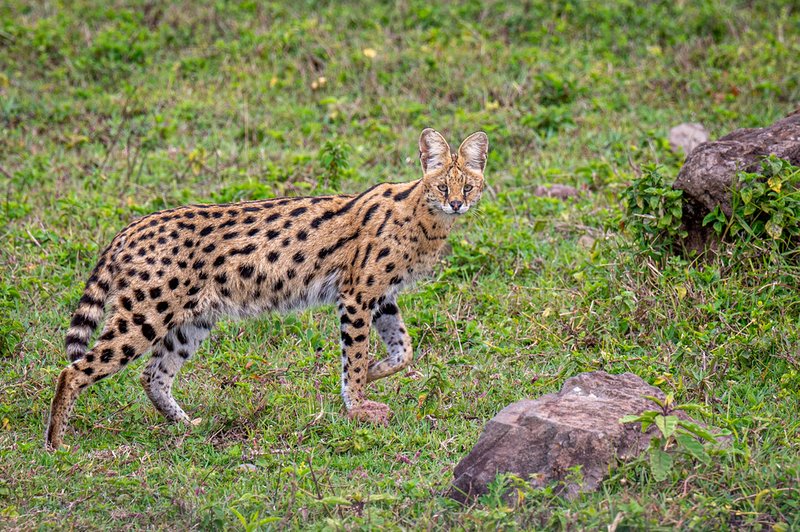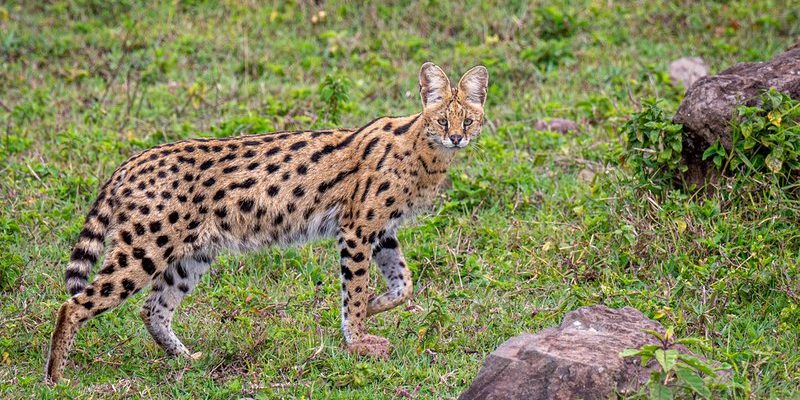
In this article, we’ll uncover the habitat and distribution of servals. We’ll take a closer look at the regions they inhabit, their preferred environments, and how these factors affect their survival. While servals are primarily found in Africa, their specific habitats can vary widely. Ready to take a closer look at these incredible creatures and learn where they live? Let’s go!
Understanding Servals: A Quick Overview
Before we dive into where servals live, it’s helpful to understand a bit about them. Servals are medium-sized wild cats that typically weigh between 20 to 40 pounds. Their distinctive appearance features a tawny coat with black spots and stripes, making them look quite striking in their natural habitat. You might be surprised to learn that servals are excellent hunters, with a unique ability to leap high into the air to catch birds.
These cats are known for their adaptability, which allows them to thrive in various environments across sub-Saharan Africa. That’s why understanding their habitats is crucial to appreciating how these animals live. They rely heavily on their surroundings for food, shelter, and safety. Let’s explore the types of habitats where servals can usually be found.
Natural Habitat of Servals
Servals primarily inhabit savannas, grasslands, and wetlands. Their preference for these environments is tied to their hunting style and the availability of prey. In savannas, for instance, the open spaces allow them to spot potential prey while also providing them with plenty of room to chase after it.
Grasslands are another popular choice for servals. These areas are rich with small mammals and birds, which make up a significant part of their diet. Servals have long legs that help them move swiftly through tall grasses, making them effective hunters. You might be wondering how their long legs play a role in hunting. Well, they can leap up to 10 feet in the air to catch birds! Isn’t that impressive?
Wetlands, which include areas like marshes and swamps, are also part of their preferred habitat. These areas provide a diverse range of food options, from fish to amphibians. Servals are surprisingly good swimmers, although they often hunt on land. The presence of water can enhance their hunting success, adding another layer to their adaptability.
Geographical Distribution: Where to Find Servals
Now that we’ve covered their habitats, let’s talk about where exactly you can find servals. They are most commonly found in sub-Saharan Africa, which includes a variety of countries. Some of the best places to see servals in the wild include:
- Kenya: The savannas of the Maasai Mara are a popular spot for servals.
- Tanzania: In the Serengeti National Park, servals thrive in the grassy plains.
- South Africa: Servals can be found in various reserves and national parks, such as Kruger National Park.
- Namibia: The more arid regions provide an interesting habitat for these adaptable cats.
Each of these countries offers a unique glimpse into serval life. You might be fascinated to know that servals are also somewhat elusive. They tend to be more active during dawn and dusk, which makes spotting them a bit of a challenge. But if you ever get the chance to go on a safari in any of these areas, keep your eyes peeled!
Adaptations to Different Environments
The serval’s ability to adapt to various habitats is key to its survival. These cats have developed several physical and behavioral traits that help them thrive in their environments. For instance, their long legs not only assist in high jumps but also allow them to cover more ground while hunting in open areas. Additionally, their keen sense of hearing is crucial when it comes to locating prey hiding in tall grasses.
In savanna habitats, the spots on their fur provide excellent camouflage among the tall grasses, helping them blend into their surroundings. It’s a bit like wearing a natural pattern that makes them less visible to both prey and predators. Interestingly, servals often rely on their sight and hearing rather than their sense of smell, which is more common in other wild cats.
Another interesting adaptation is their hunting technique. Servals are known for being incredibly agile, which helps them pounce on small mammals like rodents and birds. They can even catch multiple prey items in a single jump! This adaptability in their hunting strategies ensures they can find food, no matter the habitat.
Threats to Serval Habitats
Despite being so well-adapted, servals face several threats due to habitat loss and human activities. Agriculture expansion, urbanization, and poaching are significant factors that impact their populations. As farmland and towns spread, servals lose vital space to hunt and breed.
Another threat is the illegal pet trade. Some people capture servals to keep them as exotic pets, which can disrupt their natural behavior and survival in the wild. This is a major concern for conservationists, as it threatens the overall serval population.
Furthermore, climate change poses a long-term threat to their habitats. Alterations in weather patterns can affect prey availability and the ecosystems they rely on. Conservation efforts focus on protecting serval habitats and raising awareness about their importance in maintaining the balance of these ecosystems.
Conservation Efforts for Servals
Fortunately, various organizations are working on conservation efforts to protect servals and their habitats. These initiatives often include habitat restoration, education programs aimed at local communities, and legal protections against poaching.
In places like Kenya and Tanzania, some wildlife reserves and parks have dedicated efforts to monitor serval populations and provide the necessary support to ensure their survival. Community-based conservation programs help locals understand the importance of servals and their role in the ecosystem. By getting people involved, these programs aim to create a sense of ownership over local wildlife.
Innovative solutions, like using wildlife-friendly farming practices, are also being explored. These practices help to reduce conflicts between farmers and servals, allowing both to thrive. Everyone wins when humans and wildlife can coexist peacefully!
Final Thoughts on Serval Habitats
So, where do servals live? They thrive in a range of habitats, including savannas, grasslands, and wetlands across sub-Saharan Africa. Their ability to adapt to different environments is truly fascinating, and it’s a testament to their resilience as a species. However, they face significant challenges, from habitat loss to poaching, making conservation efforts essential.
As we wrap up our exploration of servals, it’s worth noting that every effort to protect their habitats contributes to a richer, more diverse planet. By understanding where servals live and the challenges they face, we can help support them and ensure these beautiful cats continue to grace our world. If you ever get the chance to see a serval in the wild, it’s an experience you won’t forget!

